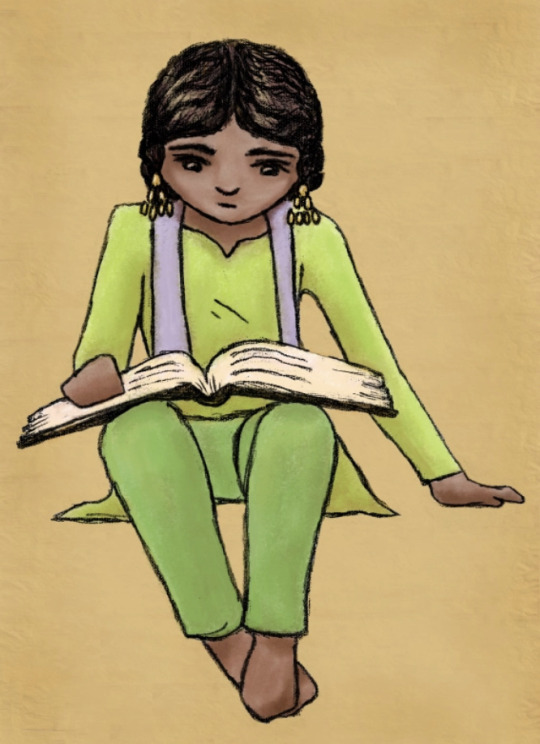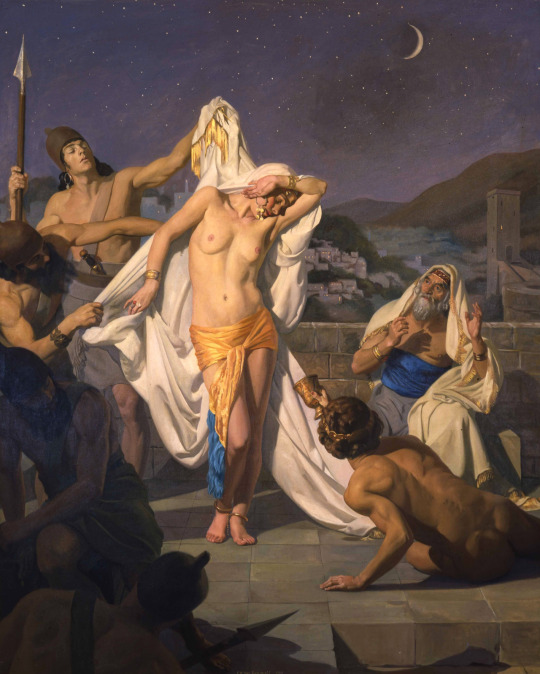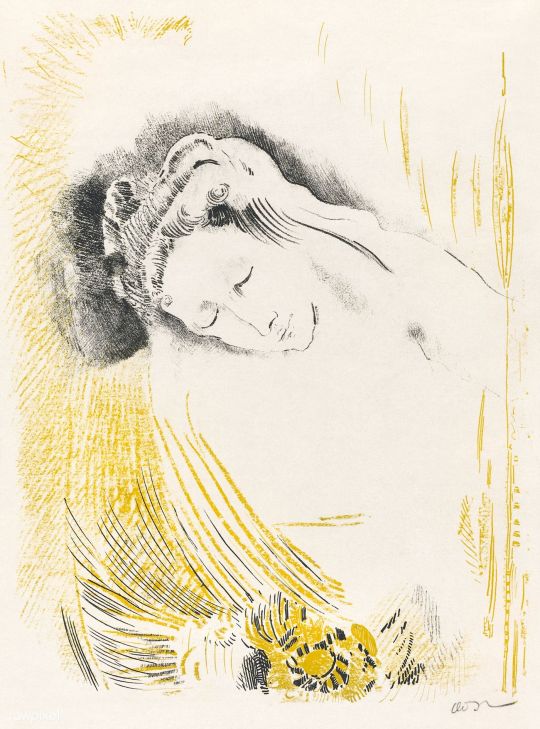#shulamite
Explore tagged Tumblr posts
Text

Scene from the Shulamite opera
Hungarian vintage postcard, mailed to Debrecen, Hungary
#scene#ephemera#mailed#photography#hungarian#vintage#briefkaart#opera#carte postale#postcard#photo#hungary#shulamite#sepia#ansichtskarte#postkarte#debrecen#postkaart#postal#tarjeta#historic
6 notes
·
View notes
Text

The Shulamite
Artist: John Roddam Spencer Stanhope (English, 1829-1908)
Date: 1878
Medium: Oil on canvas
Collection: Private Collection
The Shulamite
The Shulamite woman, or Shulamite maiden, is the bride of Solomon who features in the Song of Songs. She is only mentioned once by the title “Shulamite,” in Song of Solomon 6:13.
Solomon uses passionate language to describe his bride and their love (Song 4:1–15). Solomon clearly loved the Shulamite - and he admired her character as well as her beauty (Song 6:9). Everything about the Song of Solomon betrays the fact that this bride and groom were passionately in love and that there was mutual respect and friendship, as well (Song 8:6–7). This suggests the possibility that the Song of Solomon is the story of Solomon’s first marriage, before he sinned by adding many other wives (1 Kings 11:3). Whoever the Shulamite was, she was Solomon’s first and truest love.
#landscape#biblical scene#christianity#the shulamite#song of solomon#women#shepherds#trees#sheep#mountains#artwork#christian art#biblical art#robe#gown#costume#drapery#painting#oil on canvas#fine art#oil painting#pre raphaelite brotherhood#pre raphaelite art#christian faith#english culture#english art#art and the bible#john roddam spencer stanhope#english painter#european art
8 notes
·
View notes
Text
This is the Shulamit Music School in Tel Aviv. This school began in Jaffa in 1910 but soon moved to Tel Aviv. It was named after Shulamit Rupin, co-founder of the school, who passed away in 1912. 100% a Jewish music school. Arabs welcome, but not a Muslim business.
This photo was taken in 1914 by Avraham Soskin.

#tel aviv#jerusalem#israel#secular-jew#jewish#judaism#israeli#diaspora#secular jew#secularjew#islam#music school#shulamit#antisemitism#Judea is for the Jews#indigenous#Jews are indigenous to Judea
27 notes
·
View notes
Text
LGBTQ+ Disabled Characters Showdown Round 1, Wave 5, Poll 11


A character being totally canon LGBTQ+ and disabled was not required to be in this competition. Please check qualifications and propaganda before asking why a character is included.
Check out the other polls in this wave and prior here.
Kayla Detmer-Star Trek Discovery
Qualifications:
She was in a space battle which resulted in a severe unspecified injury to her head and left eye. Because of this, she relies on a prosthetic eye and a prosthetic of unknown use on her head. She also suffers from PTSD due to this and other incidents. It is popularly theorized that she is a lesbian, and should be in a relationship with Joann Owosekun, another character.
Propaganda:
She may have very few actual character beats or lines, but she is very cool and very gay! Let's give it up for lesbian spaceship pilots!
Submitted by @convenient-plot-device
Queen Shulamit-The Second Mango
Qualifications:
She has a severe gluten allergy which causes chronic issues. Also she is Very Lesbian
Propaganda:
Disabled Jewish lesbian queen who fights for and gets her happy beginning with her bisexual chef girlfriend in book one. She's genuinely so wonderful <3
#polls#poll#disabled characters#lgbtq characters#disability#lgbtq#lgbtq dcs round 1#lgbtq dcs wave 5#keyla detmer#star trek discovery#star trek#queen shulamit#the second mango#id in alt text
8 notes
·
View notes
Text
Former Israeli Government Minister Shulamit Aloni on Democracy Now
youtube
On 14 August 2002, former Israeli minister, Shulamit Aloni, said this on the US news program, Democracy Now:
"It is a trick; we always use it. When, from Europe, if someone is criticizing Israel, we bring up the Holocaust. When, in this country (USA), people are criticizing Israel then 'they are anti-Semitic'..
"And the organization is strong and has a lot of money and the ties between Israel and the American Jewish establishment are very strong and they are strong in this country..”
She continued, “They have power, money, media and other things and their attitude is Israel my country right or wrong... They are not ready to hear criticism. It is very easy to blame people who criticize certain acts of the Israeli government as anti-Semitic and to bring up the Holocaust and the suffering of the Jewish people and that 'justifies' everything we do to the Palestinians...."
#israel#israel america#united states#united states of america#western hypocrisy#shulamit aloni#palestine#think critically#politics#foreign policy#Youtube
13 notes
·
View notes
Text
Do you know this Jewish character?

#jumblr#jewish characters#mangoverse#Queen shulamit#jewish story premise#I need to read these books#I should do all the characters from this actually#expect more Mangoverse and falsettos characters lol#the author shira glassman is here on tumblr if you want to learn more!
4 notes
·
View notes
Text
L'apartheid dans l'entité sioniste vu par ses dirigeants
On se souvient de l’hostilité à laquelle avait été en butte l’ancien président des États Unis Jimmy Carter après la publication en 2006 de son livre «Palestine: la paix, pas l’apartheid». Ce président qui avait somme toute laissé de lui une image assez sympathique dans l’opinion internationale avait pu être dès lors affublé du qualificatif infamant d’antisémite. Ce qui est certain est que ce…

View On WordPress
#Afrique du Sud#Alon Liel#apartheid#Ariel Sharon#David Ben Gourion#Eliahu Lankin#Jimmy Carter#Mossad#Palestine#Ron Ben-Yishai#Shin Bet#Shulamit Aloni#sionisme#Tamir Pardo#Yitzhak Rabin#Zachary Foster
2 notes
·
View notes
Text
Local Co-editors Trumpet Global Diversity with Stories of 100 Jewish Brides From 83 Countries
At their wedding, David Winer breaks the glass as Adena and her mother look on./INDIANA UNIVERSITY PRESS By SHELLEY A. SACKETT In Costa Rica, where it is customary to hand-deliver wedding invitations, most of San Jose’s Jewish community was invited to Karen and Michael Bourne’s 2003 wedding. Over 350 attended. In Nicaragua, Veronica and Kurt Preiss married three times: first, in a civil…

View On WordPress
0 notes
Text
The Shulamite is a central character in the Bible's Song of Solomon. She is a young, unmarried woman who is deeply in love with her beloved. The Shulamite is considered one of the most positive portrayals of young women in the Hebrew Bible.

R.H. Ives Gammell
15 notes
·
View notes
Text

'The Dream of the Shulamite'. R. H. Ives Gammell. 1934.
262 notes
·
View notes
Text
Former Israeli Minister Shulamit Aloni: "Accusation of antisemitism is a trick we always use”.
576 notes
·
View notes
Text

Alter Kaczyne Dancer Shulamit Ram, Warsaw c.1930
57 notes
·
View notes
Text
Histroys Mosaic
At age four, Itzhak Perlman picked up a toy violin and began mimicking the sounds he heard on the radio. The sounds weren’t random; they were melodies, played back with uncanny accuracy. Born on August 31, 1945, in Tel Aviv, Perlman showed an astonishing affinity for music from the very beginning. His earliest lessons at the Shulamit Conservatory revealed a prodigy in the making, but fate added another layer of complexity to his journey. At age four, he contracted polio, leaving him with limited use of his legs. Instead of dimming his passion, the illness sharpened his focus, anchoring him to the instrument that became both his voice and his path forward.
He played sitting down, his legs braced, the violin cradled close. Teachers were initially reluctant, believing his disability might hinder his progress. But his playing silenced doubt. Within a few years, Perlman’s performances captured attention across Tel Aviv’s musical circles. His determination was equaled by his technical precision and emotional range, an uncanny combination that would define his career. By his teens, he had outgrown the local scene and moved to New York to study at the Juilliard School under Ivan Galamian and Dorothy DeLay, two of the most influential violin teachers of the 20th century. His style matured in those formative years, not just with technique, but with an emotional intelligence that gave familiar works new life.
His national debut came in 1958 when he appeared on "The Ed Sullivan Show." Viewers across the U.S. saw a young boy with braces on his legs walk slowly onto the stage, then sit and play with a depth that seemed to defy his age. That moment wasn’t simply a breakthrough for a young violinist, it was a cultural shift. Millions watched in awe, drawn not only to his talent but to the defiance with which he pursued his art. He didn’t ask for sympathy. He gave them music, pure and unfiltered.
In the decades that followed, Perlman became synonymous with violin mastery. He interpreted Beethoven’s violin concerto with both fire and finesse, brought haunting sensitivity to Tchaikovsky’s works, and delivered spirited performances of Mendelssohn and Brahms. But beyond the classics, Perlman embraced diversity in music. He performed klezmer with authentic joy, collaborated on film scores like "Schindler’s List" with John Williams, and brought Yiddish melodies to global concert halls. His versatility wasn’t about experimentation, it reflected a deep belief that music was a universal language, one that transcended genre or tradition.
He didn’t keep that language to himself. In 1995, he founded the Perlman Music Program, a haven for young string musicians with extraordinary talent. Located on Shelter Island, the program became known not only for high-level instruction but for its focus on emotional and personal growth. Perlman taught students that greatness was not only measured by flawless execution but by the ability to move an audience, to tell a story through sound. His work as a mentor was hands-on, deeply personal. He shared jokes, stories, encouragement, and demanded honesty in musical interpretation.
Collaborations with giants like Yo-Yo Ma, Daniel Barenboim, and Pinchas Zukerman enriched his career. Yet, even among other virtuosos, Perlman remained distinctive. His phrasing felt conversational. His tone carried a warmth that no teacher could bottle, no practice session could guarantee. Whether in solo recitals or with orchestras like the New York Philharmonic and the Berlin Philharmonic, Perlman’s presence was magnetic. He never rushed, never forced emotion, he revealed it.
Perlman once briefly met Humphrey Bogart in a backstage setting during a performance-related event in New York, a surreal brush with Hollywood royalty that left a lasting impression on the young musician.
Perlman’s instrument, a 1714 Soil Stradivarius once owned by Yehudi Menuhin, seemed to become part of him. Audiences didn’t separate the violin from the man. They watched him lean into each note, eyes closed, his face a portrait of every emotion he summoned. In that act, he connected across languages and cultures, from prestigious concert halls to television screens.
In a world that often idolizes speed and ease, Perlman’s life is a quiet rebellion. He achieved brilliance with effort, patience, and intention. Not despite the obstacles, but through them. Each performance reminds us that what we create matters more than what stands in our way

Source
12 notes
·
View notes
Text
10 Jewish Women from History Part 3
Shulamit Kishik-Cohen (1917-2017, Israel)
Born in Argentina, she immigrated to Mandatory Palestine as a child, and grew up in Jerusalem. At sixteen, she married a Lebanese Jewish merchant, and raised seven children with him. She established ties with the Beirut Jewish community and authorities, and helped smuggle information from Lebanon and Syria, as well as helped Jews escape. She assisted the Mossad in bringing Jews of Arab lands to Israel.
Raquel Liberman (1900-1935, Argentina)
A Polish-Jewish immigrant to Argentina. Born in the Kiev Governorate of Russia, she moved to Warsaw as a child. She married and followed her husband to Argentina with two sons. After her husband died, she began working as a prostitute though the trafficking network Zwi Migdal. She managed to buy her freedom, but was then fooled into a fake marriage with a husband who stole her savings and forced her back into a brothel. She escaped a second time and contacted a police inspector, filing a complaint in court. Her testimony brought to light Zwi Migdal's crimes, and over 100 members were detained.
Miriam bat Benayah (late 15th century-early sixteenth century, Yemen)
Daughter and sister of scribes, she was a Jewish scribe herself. She, along with her father and brothers, are credited with copying 400 books together. In one scroll of the Pentateuch, she wrote that she had copied while nursing a baby.
Hannah van Recklinghausen (1332-1349, Netherlands)
A banker and the earlies woman merchant known by name in the Netherlands. The daughter of a Jewish Court Jew from Germany, she is listed as her father's assistant and colleague from 1347.
Urania of Worms (?-1275, Worms)
A Jewish women who led other Jewish women in prayer in the synagogue, one of a handful of women to be doing said occupation in the 13th-14th centuries. he daughter of a rabbi.
Reynette of Koblenz (~1340-~1390, Germany)
A Jewish moneylender. She became a moneylender after her first husband died and continued independently through her second marriage. The size of her financial dealings surpassed those of both her husbands. In 1372, in response to the demands of the Andernacher city fathers, she raised 8,000 guildens to pay them.
Dulcea of Worms (?-1196, Germany)
A Jewish businesswoman and moneylender in the twelve century. Coming from an elite family, she married a famous Jewish theologist and leader. While her husband devoted himself to religion, she pursued economy and business. She also conducted business in parchment scrolls for extra income, and was a notable figure in the community, leading and teaching women.
Paula Dei Mansei (?-~1288, Verona)
A Jewish scribe and Torah scholar, thought to be the earliest known female Jewish scribe. Belonging to a family of scribes, she contributed to her father's biblical commentary, and translated the work from Hebrew to Italian. She also transcribed a prayer book, and a collection of laws.
Estellina Conat (15th century, Italy)
A Jewish printer and the first woman active as a printer. She was married to the man who founded the first Jewish printing press in 1475, and was active in the press independently of her husband.
Brenda Howard, 1946-2005, America)
A bisexual rights activist born in the Bronx. A feminist, she participated in and planned queer rights activities, and was active in the Gay Liberation Front and other queer organizations. Her activism included the 1987 March on Washington for Lesbian and Gay Rights.
24 notes
·
View notes
Note
🏳️🌈
any good queer book recomendations?
(Drop a 🏳️🌈 in my inbox and I’ll respond with a queer media recommendation!)
The Second Mango by Shira Glassman is the first book of the Mangoverse series, a queer Jewish fantasy series about young disabled lesbian Queen Shulamit and her family. It's very good, very sweet, and just about the most heartwarming cozy fantasy series out there.

The first book follows Shulamit after she's had her heart broken by her lady love and is trying to find other women who love women. Accompanied by a dragon-riding warrior woman named Rivka (my personal favorite character <3), Shulamit helps save a temple of women turned to stone by an evil wizard, rescue a beautiful woman from captivity, and get a wholesome sapphic happily-ever-after.
Here's the official plot summary:
Queen Shulamit never expected to inherit the throne of the tropical land of Perach so young. At twenty, grief-stricken and fatherless, she's also coping with being the only lesbian she knows after her sweetheart ran off for an unknown reason. Not to mention, she's the victim of severe digestive problems that everybody thinks she's faking. When she meets Rivka, an athletic and assertive warrior from the north who wears a mask and pretends to be a man, she finds the source of strength she needs so desperately. Unfortunately for her, Rivka is straight, but that's okay -- Shulamit needs a surrogate big sister just as much as she needs a girlfriend. Especially if the warrior's willing to take her around the kingdom on the back of her dragon in search of other women who might be open to same-sex romance. The real world outside the palace is full of adventure, however, and the search for a royal girlfriend quickly turns into a rescue mission when they discover a temple full of women turned to stone by an evil sorcerer.
The other books in the series follow Shulamit as she deals with things like "I have a severe gluten intolerance, but nobody respects my dietary needs!" and "I'm a cis lesbian in a relationship with a cis bisexual woman, but we gotta produce an heir to the throne!" and "oh no, our kingdom's crops are being affected by a mysterious blight and we have to help the farmers!" and "how do we help a gay prince from a neighboring kingdom fight against his father for the labor rights of the common people?"
The series is very Jewish, very queer, very feminist, and they're incredibly comforting. They make me believe in a better world, full of wonderful people who care about each other and fight to improve the world. It's a perfect series to read if you need something to feel hopeful about. The second book was even dedicated to a local labor rights organization in the author's city, which I think is pretty awesome.
The series gets mis-categorized as young adult fairly often, because it doesn't have explicit depictions sex or violence. It is not YA, though--Queen Shulamit is 20 years old in the first book, and by the fourth book, she and her wife have multiple children. YA is great, don't get me wrong, but this series is very much for adults!
Do yourself a favor and check it out if you're looking for diverse fantasy with a happy ending, where marginalized people get to love each other fully and triumph over difficult circumstances.
42 notes
·
View notes
Text

By Odilon Redon (French, 1840-1916)
"The Shulamite"
#odilon redon#Art#Artist#Art history#Artwork#History#Painting#Painter#Oil painting#Pastel#Symbolist#Symbolism#Symbolist art#Symbolist painting#19th century#19th century art#20th century#museum#Mythical#Mythology#Drawing#Classic painting#Classical art#traditional art#figurative#illustration#texture#traditional painting#fine art#1800s art
32 notes
·
View notes